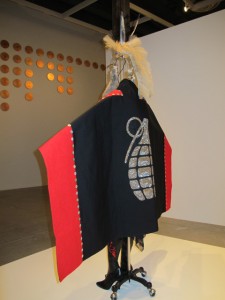
CEREV Fellow’s Reflection: Aboriginal Self-Definitions and Self-Representations in Canadian Artscapes and Academic Spaces
Aboriginal artistic, curatorial and academic practices are an indispensible part of discourses of decolonization, as always-political “strategic visibilities” that are essential for a diverse affirmative Native presence in a multi-diverse Canada (and beyond).
My short-term research stay at CEREV included attendances at transcultural visual arts and curatorial symposia, lectures, seminars, working groups, and visits to various urban art and museum spaces in Montreal (Concordia University, McGill University, McCord Museum, Art Mûr), Toronto (Ryerson University, The Power Plant), and Sherbrooke (Foreman Gallery). I explored progressive alterNative counter-curatorial practices and methodologies for critical place-making, through visible manifestations of hidden knowledge and narratives. I observed invisible scars-capes expressed and presented in heterogeneous materials, performances, and academic presentations within Euro-Canadian academic and art spaces, which functioned as intercultural contact zones connecting Indigenous and non-Indigenous inhabitants.
These included the symposium Pictures of by Indians featuring leading Aboriginal curators/scholars such as Steven Loft and Rachelle Dickenson, and artists such as Scott Benesiinaabandan, Rosalie Favell, Mary Longman, Shelly Niro, Jeff Thomas, etc. The exhibition Beat Nation at The Power Plant in Toronto, accompanied by curatorial lectures, the exhibition Decolonize Me at the Foreman Gallery, a lecture by and scar workshop with Nadia Myre, lectures on the invisibility of difficult knowledge (residential school lives, hate crimes, reserve realities, various forms of lethal racism), and healing ceremonies and protestations through live performances of Aboriginal acts of resistance and resilience. Internationally acclaimed Indigenous artists such as Rebecca Belmore, Skeena Reece, Nadia Myre, Scott Benesiinaabandan, Shelley Niro, and Jeff Thomas have uncovered difficult pasts, and their works testify to ongoing colonial realities in traditional yet progressive ways. I had the opportunity to engage with counter-narrations in which Indigenous artistic and co-curatorial practices influence and reclaim cultural discourses in Canada and beyond.
If, as curator and Professor Jennifer Kramer (UBC, MOA) wrote,* artist-warriors implement representational changes in still hegemonically-structured museums or art spaces to creatively decolonize Western ways of perception, interpretation, and discussion, there is still a long way to go: there is, for example, still not a single Aboriginal artwork present at the MAC (Musée d’art contemporain) in Montreal (and how many Aboriginal experts have to work as independent curators instead of full-time staff members?).
I am very grateful to Professor Erica Lehrer, Director of CEREV, for accepting my PhD research fellow application, sponsored by Humboldt-Universitaet zu Berlin’s Institute for English and American Studies, and by the GKS. I also gratefully acknowledge Inuit curator, artist, and professor Heather Igloliorte for inviting me to attend her seminar on Aboriginal art in theory and practice, for her time, for her additional recommendations before and during my stay. I would also like to thank Professor Laurence Kirmayer and Amber Berson for their insights into forms and strategies of healing in the aftermath of mostly invisible violence against Indigenous communities and their members.
Post by Amina Grunewald
* “Figurative Repatriation: First Nations ‘Artist-Warriors’ Recover, Reclaim, and Return Cultural Property through Self-Definition.“ Journal of Material Culture, July/9: 161-182, 2004.



